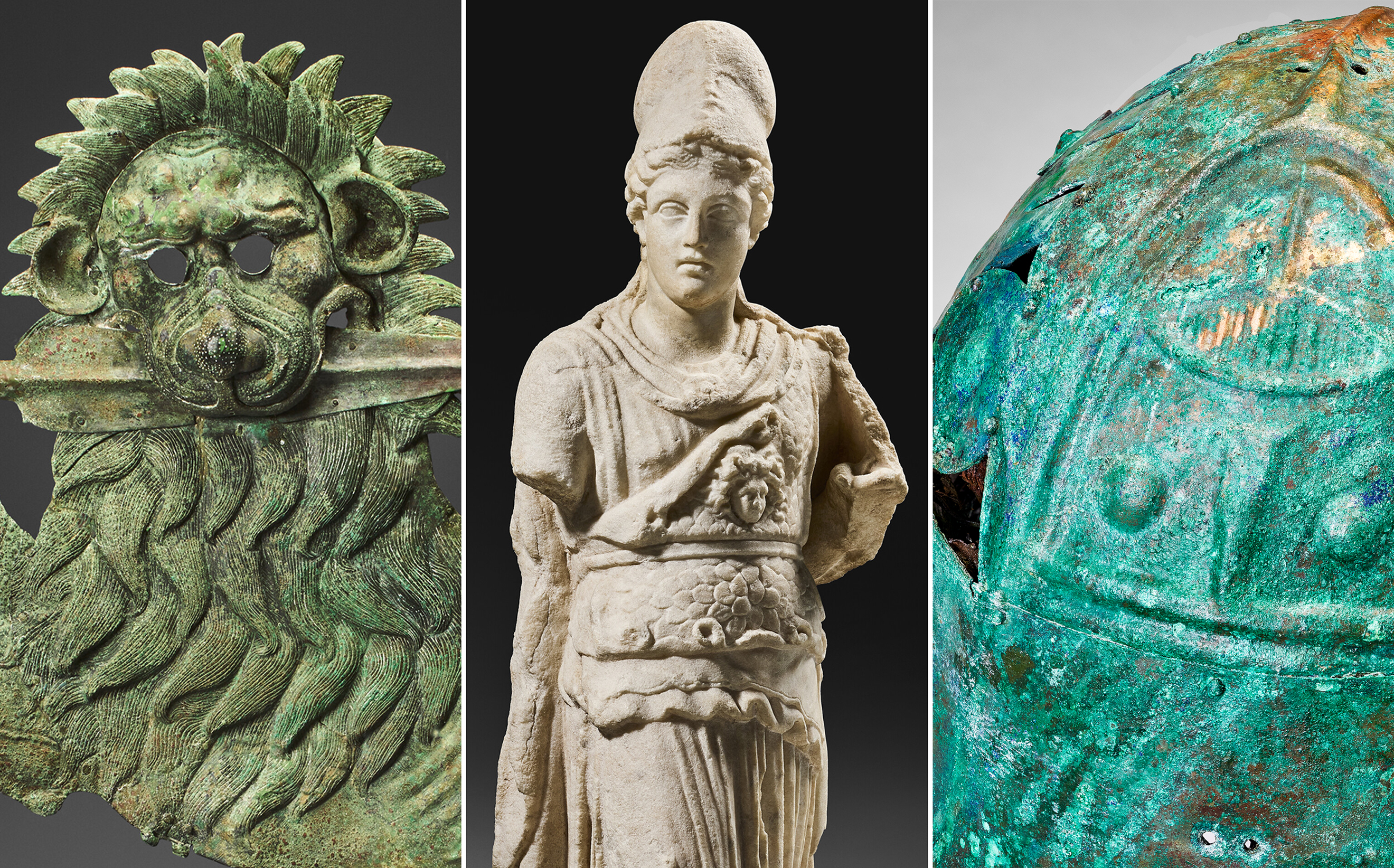A specialist’s look inside the most prestigious private collection of arms and armour in the world
Christie’s Antiquities specialist Maxwell Murphy breaks down the history of a lion shield blazon, a Picenian helmet and more from the Mougins Museum of Classical Art

Main image, from left to right: A Greek bronze lion shield blazon, c. 400-300 BCE. Height: 24⅝ in (62.5 cm). Estimate: $400,000-600,000; A Roman marble Athena, c. 1st-2nd Century CE. Height: 43¾ in (111.1 cm). Estimate: $200,000-300,000; A Picenian bronze helmet with leather and basketry lining, c. 7th Century BCE. Height: 12⅝ in (32 cm). Estimate: $150,000-250,000. All offered in Arms and Armour from the Mougins Museum of Classical Art, Part II on 8 October 2024 at Christie’s in New York
From 2011 to 2023, the Mougins Museum of Classical Art in the south of France housed its founder Christian Levett’s exceptional grouping of Classical art and antiquities, including the largest private collection of arms and armour in the world.
Beginning in December 2023, as Levett began a new chapter with the founding of Femmes Artistes du Musée de Mougins — Europe’s first major museum dedicated to women artists — antiquities enthusiasts were offered a rare opportunity to acquire works from Levett’s superb collection in A Collecting Odyssey: Property from the Mougins Museum of Classical Art, a series of six auctions at Christie’s.
On 8 October the odyssey continues in New York with Arms and Armour from the Mougins Museum of Classical Art, Part II, offering helmets, shields and panoplies from every period of Greek and Roman history, as well as vases, sculptures and reliefs that illustrate how they used. Maxwell Murphy, Associate Specialist, Ancient Art and Antiquities, offers his insight into what makes three of these objects unforgettable.
A Greek bronze lion shield blazon
A Greek bronze lion shield blazon, c. 400-300 BCE. Height: 24⅝ in (62.5 cm). Estimate: $400,000-600,000. Offered in Arms and Armour from the Mougins Museum of Classical Art, Part II on 8 October 2024 at Christie’s in New York
‘The remarkable level of detail makes this piece very special. The raised veins on the lion’s ribcage and the mane around his head come from both casting and cold-working techniques, like punching and engraving, while the hollow eyes would have been inlaid with precious materials, and the sword gilt in silver. Due to the details and the motif, it likely belonged to a prominent warrior who had proven themselves in battle many times.’
A Roman marble Athena
A Roman marble Athena, c. 1st-2nd Century CE. Height: 43¾ in (111.1 cm). Estimate: $200,000-300,000. Offered in Arms and Armour from the Mougins Museum of Classical Art, Part II on 8 October 2024 at Christie’s in New York
‘We don’t know whether this statue was made for votive or personal use, but considering the intricate detail of the marble and its scale, it may have been placed in a Romma villa. There its owners would have looked upon this ancient warrior every day.’
A Picenian bronze helmet with leather and basketry lining
A Picenian bronze helmet with leather and basketry lining, c. 7th Century BCE. Height: 12⅝ in (32 cm). Estimate: $150,000-250,000. Offered in Arms and Armour from the Mougins Museum of Classical Art, Part II on 8 October 2024 at Christie’s in New York
A Collecting Odyssey: Property from the Mougins Museum of Classical Art will conclude in December 2024 in London with Antiquities from the Mougins Museum of Classical Art and Works of Art from the Mougins Museum of Classical Art, Online
Sign up for Going Once, a weekly newsletter delivering our top stories and art market insights to your inbox


